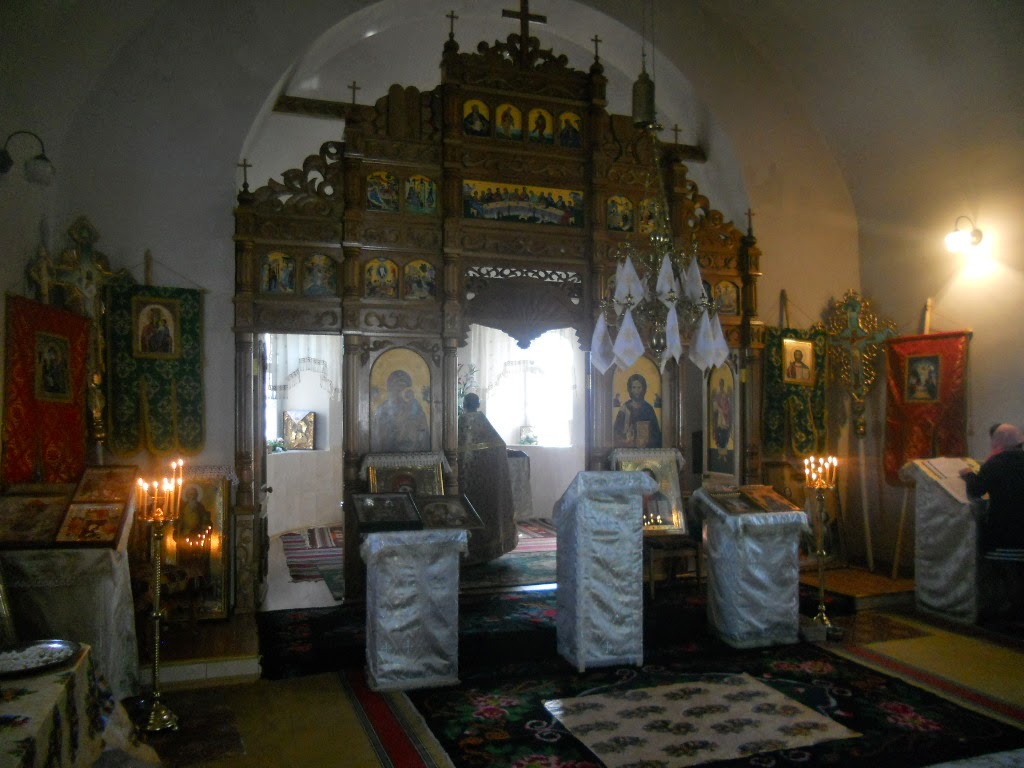 |
| The Orthodox church in Jeloboc. |
 |
| Beautiful icons tell religious stories. |
 |
| Hristos. |
 |
| Maica Dumului |
 |
| Jeloboc cemetery |
 |
| grave markers have been painted |
 |
| Families gather at the grave sites. |
 |
| Neighbors celebrate their families. |
 |
| Julia's sisters and family gather. |
 |
| The old guys wait on a bench. |
 |
| The priest blesses the graves. |
 |
| Wine is poured in the sign of the cross. |
 |
| Deceased family members are named by the priest. |
 |
| Auntie tries to spoil Liviu. |
 |
| Grandma Iulia is a safe harbor. |
 |
| Everyone love's the little guy. |
 |
| I receive gifts of remembrance. |
 |
| Other family are included in the sharing. |
 |
| Mmmm, little ones will play |
 |
| Liviu |
 |
| Ecaterina |
 |
| This is fun. |
 |
| A family picnic in the cemetery, |
 |
| Lot's of good food. |
 |
| The priest stops for a bite of food. |
You thought Easter was all over, done for another year. Nope. Not here in Moldova. Today was Blaginilor Easter or Easter of the Blessed. Another way of saying that is Easter of the Dead. This is an Orthodox Christian tradition that has not carried over to our Western Christianity. If there is one celebration that I would advocate imitating from our Eastern European neighbors, it is Blaginilor. The Sunday after Easter the relatives of those buried in the church cemetery come to remember them in light of the hope of Resurrection. It's like a religious event, but also a very personal family reunion of the living and the dead. One nice things is that everyone comes the week before and spruces up the graves of their family. Weeds are removed, markers are repainted, some new crosses are installed just for the occasion. Everyone comes to the cemetery on Sunday morning and places mementos on the graves. Let's just say these are things that show our care and affection for their needs. Bread, cups, a knife, candy, Easter eggs (colored red), hand towels, a glass of wine and a church candle in each one of these items. The priest with a cantor comes to each grave site and will incense the grave, pray for the list of family members buried there, and finally pour some wine in the sign of the cross on each grave. During the morning, while the priest is making his way from grave to grave, the people of the village are mixing it up with hugs and hand shakes and shots of wine to remember their past friends and neighbors buried here. ( I must have taken at least twenty shots of wine in the two hours that we were there.) After the priest has made his visit to your family grave sites, then you are free to share the items of the grave offerings with other relatives and friends. You give them some candy or a cup or a towel and say "this is in remembrance of my father or mother or sister" remember their souls in your prayers. Then the blankets come out and spread on the ground. Some families have a permanent bench or table and bench at their grave site for this special day. Now we all enjoy a picnic meal that is full of good food items such as sarmale, placinta, carnati, brinsa, collaci, radici, rosie, castrovati, torta si mai multe pahare de vin sunt împărtășite. (yes, many glasses of wine) Many of the children are treated on this day by grandparents and uncles and aunts treating them with many candies and foods that they enjoy. I think it has a serious challenge to Christmas as a special day for treats. Hristos, a inviat. Advederat inviat. (Christ is risen. He is truly risen) This is how we greet each other today and for the following weeks until the Easter season is over. May your family be well, now and forever.
How beautiful! In some ways, it reminds me of Mexican families gathering in cemeteries on November 2. That closeness of family and community is a rich treasure. Glad you got to be part of it!
ReplyDelete